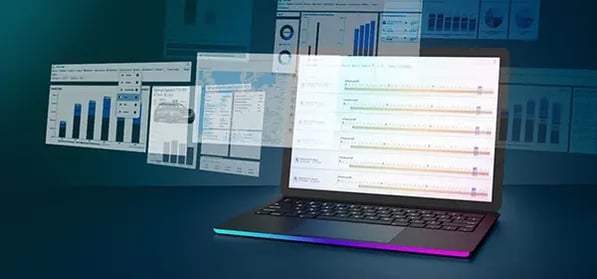3 min read
Benchmarks and Success Factors for the Top10 Sales KPIs
 Erik Reiter
:
Oct 2, 2024 2:37:52 PM
Erik Reiter
:
Oct 2, 2024 2:37:52 PM
Tracking the right KPIs is essential for automotive suppliers to ensure profitable growth. Understanding benchmark values and applying success factors can help you gauge performance and implement effective strategies. Below, we explore the top 10 sales KPIs, their benchmarks, and how to achieve them.
KPI 1: CAGR: Own Growth Rate vs. Market CAGR
Benchmark: For strategic markets, your own CAGR should be at least 2-3 percentage points higher than market growth.
Success Factors:
-
-
Use S&P Global Mobility data and forecasts to compare it with your growth rates.
-
Align your growth strategy with market trends.
-
Invest in R&D to innovate and stay competitive.
-
Focus on strategic target projects and align the organization to win this business.
-
KPI 2: Market Share
Benchmark: Top players often hold between 20-30% market share in their respective product categories, but this varies significantly by region and product type.
Success Factors:
-
-
Conduct market segmentation to target underserved areas.
-
Strengthen relationships with OEMs to secure long-term contracts.
-
Follow your customer strategies in terms of footprint and technology. This always pays off long-term, even if the EV strategy is critical at the moment.
-
KPI 3: Order Intake
Benchmark: the turnover over time (TTO) of the newly acquired orders in one year should be 30% higher than the current actual annual turnover.
Success Factors:
-
-
Strengthen OEM relationships.
-
Install target costing in the acquisition phase.
-
Ensure management attention is focused on winning business.
-
KPI 4: Strategic Hit Rate
Benchmark: High performers achieve a hit rate of 80% on targeted projects, while the hit rate for all quoted business is typically 25-35%.
Success Factors:
-
-
Focus the whole organization on the strategic targets.
-
Focus on targeting the right projects aligned with your strengths.
-
Track and learn from lost deals to continuously improve.
-
KPI 5: Profit Driven by Change Management
Benchmark: Top performers achieve >8%, though product type has a significant impact on this figure.
Success Factors:
-
-
Visualize the profit for every change before the quote is submitted.
-
-
-
Generate a change performance culture by visualizing overall change results and tracking them by project, business unit (BU), and region.
-
Ensure external changes (technical updates, customer demands) result in price increases that outpace cost hikes.
-
KPI 6: Claim Performance
Benchmark: Industry benchmarks suggest that >15% of annual sales should be recovered through claim performance, especially in times like now where there are significant volume deviations compared to contracts.
Success Factors:
-
-
Establish an automated warning system to visualize all deviations that occur.
-
-
-
Communicate transparently with customers regarding deviations.
-
Regularly audit contracts to ensure accurate terms and conditions.
-
KPI 7: Claim Aging
Benchmark: Aim to resolve claims within 60-90 days to maintain liquidity and avoid escalation.
Success Factors:
-
-
Implement automated reminders and escalation processes for unresolved claims.
-
Regularly review the financial impact of unresolved claims on liquidity and profitability.
-
Set clear weekly tasks to move forward in resolving claims.
-
KPI 8: Total Amount of Under- and Overpayment by Amortizations
Benchmark: The ideal benchmark for underpayments is 0; every deviation should lead to a customer meeting with a resolution.
Success Factors:
-
-
Create transparency on all contractual amortization agreements.
-
Create an automatic alert system for any deviations.
-
Immediately engage with customers when deviations are identified.
-
9. Prices Without a Purchase Order
Benchmark: Aim for 100% of your sales to have corresponding purchase orders.
Success Factors:
-
-
Strengthen internal controls to ensure all sales are properly documented with purchase orders.
-
Train sales staff on the importance of adhering to purchase order requirements.
-
Audit sales processes regularly to identify any discrepancies.
-
10. Profit for Each Project in RfQ and Booked Business Phases
Benchmark: Profit margins should be between 8-12% during both the RfQ and booked business phases, and 0% of the projects should be loss-makers.
Success Factors:
-
-
During the RfQ phase, ensure accurate and thorough cost calculations to avoid underpricing.
-
Once a project is won, focus on managing change requests and claims to maintain profitability.
-
Continuously review project performance to identify areas for process improvement.
-
By tracking these KPIs and adhering to these benchmarks and success factors, automotive suppliers can stay competitive while fostering sustainable growth. Digital Automotive does not only offer monitoring, but it also provides benchmark processes that guide sales professionals to focus on profit and cash, along with approval processes to ensure compliant behavior. Schedule a live demo today to see how our solution can help you achieve your business goals!
Curious to see how these challenges are addressed in the leading sales planning and sales management solution? Schedule a live demo with Digital Automotive today!




